Succulents are considered one of the most unusual and excellent plants that are surprised by their appearance and characteristics. Probably there is not a single house where the small cactus would not grow in a bizarre pot. Many gardeners try to diversify their gardens and pretty unusual plants for this, such as Rhodiola Pink - a distant relative of cacti, possessing the same ability to accumulate water in their fleshy leaves.
More recently, the natural habitat area of \u200b\u200bthis culture was quite extensive, but after the massive interest of people to the plant of Rhodiola, his population declined sharply, which was the reason for making in the Red Book. It did not prevent the gardeners increasingly planting this unusual flower in her garden and on the flower. Rhodiola, landing and care in open soil for which is quite simple and understandable, will become an excellent decoration of any site.
In this article, consider the features and description of the Rhodiol, as well as we present the characteristics of popular varieties of culture. We note the important moments of landing and growing Rhodiola in the open soil.
Features and morphological description Ramiol
The Rodiol plant is a mountain herbous perennial who belongs to the Tolstanka family. She is a representative of succulents. The place where Rhodiola grows, most often mountainous or stony. Today, culture can be found in the hard-to-reach mining areas of Scandinavia, Altai, Pamir, Tien Shan, in the Balkans, Carpathians, Transbaikalia, North America and the United Kingdom, on the coast of Barents and the White Sea, in the Urals and Siberia. As you can see, this succulent was just a great distribution, but today this amazing plant is listed in the Red Book as an extinct view.
Rhodiola has just a huge centuries-old history, which consists of various legends and legends regarding its origin. For the first time, a perennial plant was described in the 1st century AD. Physician Dioscarid. For a long time, Rhodiola or Golden root was considered a healer plant that helped extend life. Tincture and teas on the succulent saw Chinese emperors, Altai hunters, vikings and shepherds. The plant was especially popular in Altai, the fame of which spread far around the world. It was on Altai that people began to come in search of a golden root. The secret of this plant knew only the indigenous people who did not reveal the secret of his sigh species. That is why for many years of the expedition of scientists could not find the famous golden root, while a beautifully knowing the plant called Rhodiola pink.
And only in 1961, one of their expeditions was established that the legendary golden root and Rhodiola pink are the same plant. After this discovery, tourists began to appear on the territory of Altai, who disappeared and dug up the healing roots of Rhodioli, which led to the extermination of the plant and making it in the list of protected.
Rhodiola or Rhodiola received its scientific name in 1755, which she gave her a famous scientist Karl Linney. The origin of the definition of Greek from the words "rhodon" or "rhodia" or Latin from the word "roseus" - in translation denoting "pink", "Rose". This is due to the fact that when the root of the Rhodiolate, a pleasant smell appears, which resembles a rose flower aroma. You can often hear the names of the Golden root or pink root. The golden root is called this plant due to a pearl shade of the root, others argue that in the context of the roots become pinkish - from here and pink root.
Description Rhodiol:
- Rhodiola is a perennial herbaceous plant that belongs to the family of Tolstanka, although some time of this representative of succulents attributed to a completely different kind. Previously, all the varieties of Rhodiola were attributed to the clan or sedum.
- This plant has a very thick and meaty tuberous rhizome, which very much with its appearance resembles a human hand with five fingers. The rhizome itself is almost on the surface of the soil, and the subtle roots of Rhodiola go deep into.
- Rhizome has a brown-brown shade with pearl shine flakes. It is from such a color of the root and a popular plant name occurred - a golden root. Another feature of the tuber's tube rowing is a large number of renewal kidneys, which contributes to the growth of perennial.
- From the kidneys of the resumption, there are reprehension or slightly curved, not branched stems. On one plant there may be several of them, it all depends on the specific variety of Ramiol. On average, the stems are 10-15 in adult busta and 1-2 in a young plant.
- Stems are very thick and fleshy, which indicates the belonging of this plant to succulents, which thus accumulate water.
- In the height, all shoots can reach a height of 10-60 cm, it all depends on the type and variety of the Ramiol.
- The leaves are sedentary, the next, very thick and fleshy, are located on the stems of peculiar tiers almost at right angles.
- On the surface rhizome or caudax leaves of scratched, they have an oblong oval or triangular shape on the stems. Sheet plate on the end pointed and the edge of the gear, has a light green color with a bluish tint.
- Flowers Rhodiola same-sex, on one bush can only be men's or only female. In this case, it is possible to quite easily determine the belonging of the colors to a specific floor: men's flowers are brighter and large, and women can even stay green during flowering.
- Flowers of this plant can have a different structure: there are five-membered or hexted.
- Little flowers of a yellow shade are collected in shovels or blurred inflorescences on the tops of the stems.
- Blossoming Rhodiola begins approximately at the end of May or in early June.
- After flowing colors on the tops, the fruit appears in the form of red or green leaflets. The length of one leaflet can be 6-8 mm.
- At the end of June or at the beginning of July, the family seeds ripen, who possess very small sizes.
- This representative of succulents is often used for decorative decoration of the site and for therapeutic purposes, due to its useful properties and content of a large number of useful vitamins and substances.
A variety of species of Rhodiola
To date, scientists have studied about 60 varieties of Rhodians who have different habitat and external characteristics. Consider a description of the most popular and common types of this plant.
- Rhodiola "golden root" or R. Rosea. This is the most popular type of culture, which is most often described in literary sources. The height of the stems of Rhodians reach about 30 cm. They are very thick and fleshy and densely covered with oblong, egg-shaped leaves, which are much larger in size from above than below. On average, the length of the leaves can reach about 2.5 cm. On the tops of the stems are blooming small, same-sex four-colored flowers, which are collected in palate inflorescences, in diameter reaching 7 cm. Due to the large number of renewal kidneys, it forms lush curtains. The variety is very winter-hardy. The natural area of \u200b\u200bhabitat is the territory of the Far East, Siberia, Altai and Arctic regions of Russia. Popted as a famous medicinal plant.
- Rhodiola "Kirillova". The natural area of \u200b\u200bthe habitat of the Rhodium of this variety is the territory of Tibet, Tien Shan, Altai, North-West China. The height of the stems together with the cakex is approximately 60-90 cm. The plant consists of a small number of color seals. Stems densely covered with linear lanceal, pointed, dark green leaves. Blossom starts at around in early May and lasts for a month. Most varieties please be green or yellowish-green flowers, but there are varieties with red flowers.
- Rhodiola Volodulatovoid or R. Bupleuride. It is an herbaceous perennial, which in height can reach about 50-60 cm. It usually consists of a small amount of fleshy and thick stems, thickly coated with oblong oval or elliptic leaves of a saturated green shade. This variety blooms with bright colors, the shade of which can be from red to black and purple. Small plant flowers are assembled into dense shield inflorescences.
- Rhodiola frosty. Another type of this representative of succulents. It is a low plant with very decorative appearance. In the height of the stems reach only 20-25 cm. Tight shield inflorescences consist of dark pink flowers, whose petals are longer than chashelistic.
- Rhodiola perist delicate or R. Pinnatifida. The plant of low growth consists of a small number of reprehension stems, which are thickly covered with fastened tops with the leaves. Plumatic inflorescences on the tops of the stems consist of small bright yellow colors.
- Rhodiola is a reclocked. It is a plant that is very popular due to its unpretentiousness in care and decorativeness. The natural area of \u200b\u200bhabitat variety is the territory of Himalayas, Tien Shan, Tibet, Altai, Pamir. Strengthening stems covered with triangular egg-shaped leaves. Sheet plate has a husky shade. Men's flowers have a bright brick-red shade.
- Rhodiola Sakhalinskaya. This type of plant is widespread in the wild. It is a low stems up to 30 cm. The tube rhizome or caudax have healing properties.
- Rhodiola bright red or R. Coccinea. This is a very spectacular and decorative kind of rhodium, which boasts bright dark red or red-pink inflorescences.
- Rhodiola lineing or R. Linearifolia. This variety resembles a variety of Kirillov, but has a slightly smaller size. Porolo flowers with brick-red flowers.
Returning Ramiol: The most common ways
Each gardener can independently grow on its site a whole plantation of the golden root or rhodisol and admire the bright flowering of culture. In order to dilute the plant, you need to know suitable methods of reproduction. For this representative of the Tolstanka family, several reproduction options are available: seed and vegetative, and more specifically reproduction of rhizomes division. Consider the rules and features of each method.
Seed reproduction of Ramiol
- The seeds of the Rhodiola externally cannot be distinguished from the seed of the clearing, whose nature earlier this plant was attributed. Therefore, during the purchase of planting material, you need to be very attentive and better choose verified stores.
- The cultivation of the family of seeds is considered the most affordable and justified way, since the gardener can immediately receive many male seedlings and female, which will further facilitate the receipt of a full-fledged flower beds from perennials.
- First of all, it is important to know that the acquired family seeds need to wake up. For this, the process of stratification is carried out. If not to do this, then the percentage of germination will be very low or seeds will not come up at all.
- Seeds are sown in the tank late fall or in winter. You can engage in sowing and spring, holding the seeds before this in the refrigerator.
- Pick up a suitable box or container, the depth of which will be more than 10 cm. Put a small layer of clay in the bottom of a drainage, and on top of pour nutritious soil.
- The soil is well moistened and the seeds are smelted from above, about 0.1-0.2 grams of seeds per 1 sq.m.
- It is not necessary to close the seeds, sufficiently press them.
- After that, the box is covered on top of the film and is displayed on the balcony or quenched on the garden in the garden at one level with the surface of the soil.
- Thus, the seeds will pass natural stratification during the winter.
- If it is impossible to carry out such a process, it will be enough to put seeds by 1.5-2 months in the refrigerator.
- In the spring film from the boxes should be removed. At the same time, the first searches will begin to appear. Do not be afraid that seedlings appear unevenly and slowly. This feature of the plant.
- Until next spring, it is recommended to leave boxes in the ground. At the same time, parental care will be in regular irrigation. At the same time, boxes must be placed in bright places, but with shading at noon.
- For permanent location, the seedlings are planted only on the second spring, after preparing the soil.
- It should be borne in mind that such plants will bloom only for 2-3 years. And already for 5-6 years, they can be breeding vegetatively.
- It is important to remember if you want to independently get the seeds of this plant, men's and female copies should grow on your site, so that the fruits can tie and ripen seeds.
Reproduction of parents dividing bush
- Ramiolo can be dissolved independently and with the help of a vegetative way.
- Very often, this method is used together with the collection of healing raw materials, which is held once every two years.
- Conduct the fission of rhizomes in spring or autumn.
- To do this, it is necessary to dig up an adult plant and neatly using a sharp knife to divide the rhizome into several parts in such a way that each decene has 2-3 renewal buds.
- When dividing a large rhizomes, the deteen should be about 10-15 cm long.
- After division, it is necessary to use the sections of the sections to be treated with a rotten coal or row. Also, many gardeners recommend slightly to dry the decene to avoid their rotting.
- After that, prepare the seat and land the parts of the root to a permanent place in such a way that the kidneys remain on the surface.
Landing Rodiolov in Open Soil
The process of landing Rhodiola pink into open ground is simple enough and should not cause difficulties in gardeners. The main thing is to clearly and correctly perform all the stages of preparation and landing so that in the end, to get a beautiful perennial herbaceous plant.
Stage 1. Selection and purchase of the landing material Ramiol for open soil
- First of all, each gardener needs to take care of the acquisition of high-quality planting material.
- If there is no adult rhodium plant on your site, which can be used for breeding, you can buy seeds or seedlings Rodiol Pink and land them in the garden.
- If you are poorly understood in the seeds, it is better not to risk and buy ready-made seedlings or decenes of this plant, as the seeds can be confused with the seeds of the clerk.
- Buy seedlings are best in proven garden shops or nurseries that are professionally engaged in breeding plants.
- Most often in such farms, seedlings are sold with a closed root system in small containers with a volume of more than 1 liter. This allows young plants to develop the root system well. You can also find decens from an adult rinol plant plant with several kidneys of growth.
- Before buying, it is recommended to carefully check the appearance of the planting material. If you buy seedlings in pots, then inspect the soil in containers - it should be clean and moistened. The top of this should look fresh and have a completely healthy look. When buying a decene, pay attention to inspection of the appearance of rhizomes and kidneys. The kidneys must be alive, and the strawberry itself is elastic.
Stage 2. Choosing a place for landing Rhodians in an open soil
- The next important step will be the choice of the most optimal place on the site for the landing of Rhodiol.
- This moisture-loving plant prefers to grow at open solar sites, where there is a large amount of sunlight throughout the day. The exception is noon when Rhodiola needs a small shadow.
- This plant can grow in a small shadow, the main thing is that it is not constant.
- For Rhodiola pink, it is important that the selected area is well protected from strong wind and draft, which can lead to the appearance of diseases.
- It is also preferable to plant young rhodium plants to slightly elevated areas with lots of stones.
Stage 3. Choice and preparation of the soil for landing Rhodiola in open soil
- Rhodiola is a relatively unpretentious plant that can be grown almost everywhere.
- It is desirable to choose a sooth of a weak or neutral reaction.
- This plant feels perfectly in fertile, loose and light soils, so Ideal if the soil is drowned in your site.
- Do not land Rhodiolate in wetlands. Although this plant loves moisture, but at such sites can start rotting.
- Usually the landing place is preparing in advance. If you are planning an autumn fit, then prepare the soil in spring or summer. Autumn preparation of the landing site is recommended for spring planting seedlings.
- The soil must be carefully overcooked and add humus or other organic fertilizers to it.
Stage 4. Planting the Rodiol in Open Soil
- First of all, at the selected in advance, it is necessary to outline the location of the seedlings. To do this, you can take the usual cord and, apply it to the surface of the soil, mark the distance between the individual beds at 50-70 cm and between the individual plants at 20-50 cm.
- If the ground on the plot is more clay, then it is recommended to add river sand. With high acidity, do not forget to deposit dolomite flour.
- The size of the well should not be too large, since part of the rhizomes should still remain on the surface.
- Pre-paint rich pots with seedlings if you bought young plants with closed roots. After that, the transshipment method will transfer them to the prepared wells.
- If you use deteen, blow them into the landing pits, leaving the part of the root on the surface.
- After landing, be abundantly plenty of Ramiolu.
Agrotechnique of growing Ramiol: Secrets and nuances of care
Poriolois care is quite simple, subject to the choice of the optimal place to disembark the plant and the proper planting process.
- Watering. Rhodiola is considered a moisthed plant that spares water in its thick leaves and stems, but for a long time to do without irrigation can not. This plant prefers flowing watering when it is not overhead, and under the root. Watering the plants is necessary when dried up the top layer of the soil.
- Loosening and mulching. Regularly the surface around the plants is recommended to loosen to ensure the access of oxygen to the roots. It is necessary to loosen very carefully, since the root system is almost on the surface itself. The soil can be cluttered with fallen foliage or grass to prevent the roots overheating. Also, over time, the rhizome Rhodiola gets out the outside, so it must be sprinkled with nutritional soil or dip.
- Feeding Rhodiola is in dire need of regular feeding. It is usually recommended to conduct 2 feeders, the first of which falls on active vegetation. Most often to fertilize plants, a dung alive is used. For this, 5 days fresh manure insist, after which they are bred in water in a ratio of 1 to 4.
- Pests and diseases of Rhodiol. This plant is very rarely affected by various diseases and exposed to the insumage of pests. Sometimes bushes can get milded dew or black leg. In this case, it is necessary to use special chemical preparations. At the same time, remember that it is impossible to use a plant for therapeutic purposes after processing at least 6 months. From pests sometimes you can meet a weevil. It is not recommended to use chemicals, you can simply shake insects on a sticky surface and destroy them.
- Shelter for the winter. In order for the Rhodiolation to not frozen in winter, in the late autumn it is recommended to highly emphasize the root of the plant and to be meditated with peat or humus.
Rhodiola - Photo
Rhodiola Pink is a bright representative of succulents, which perfectly fit into any garden composition. At the same time, landing and care for this culture is so simple that even the gardener-novice will cope with all actions.

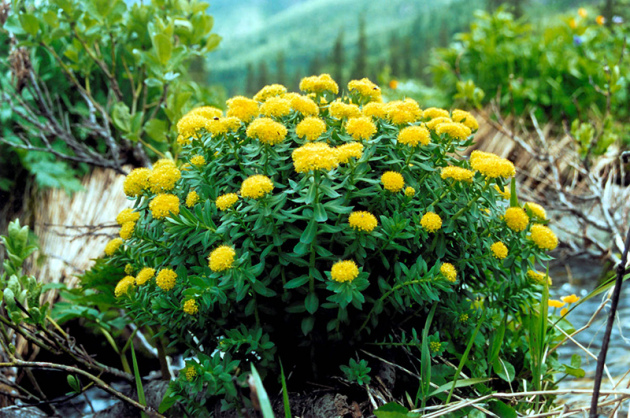

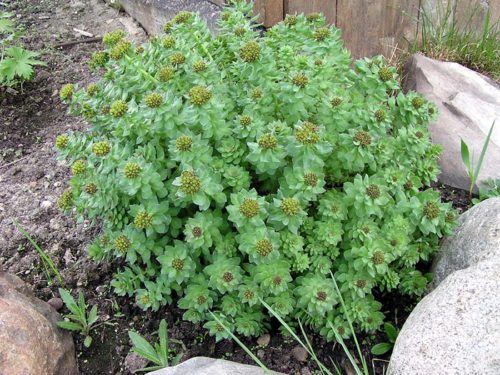
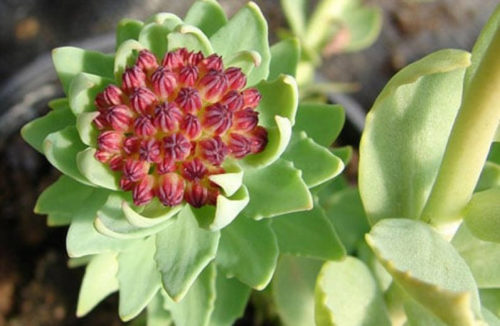
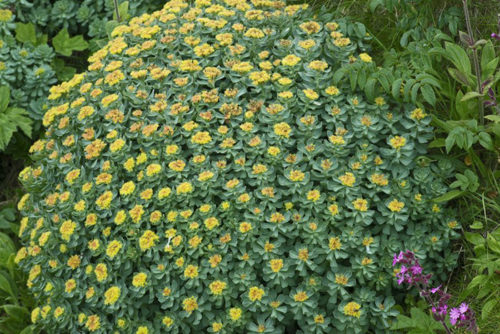
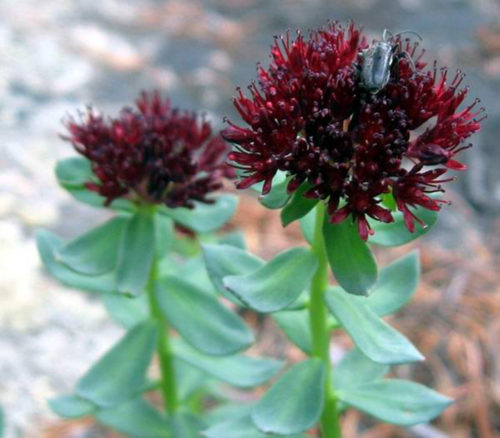
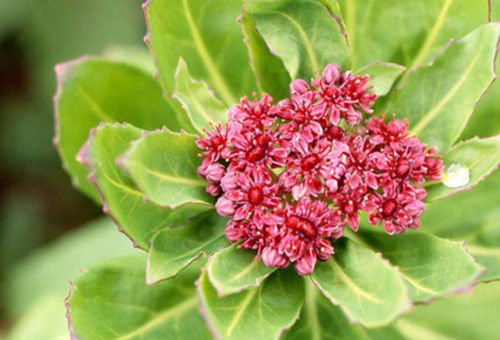
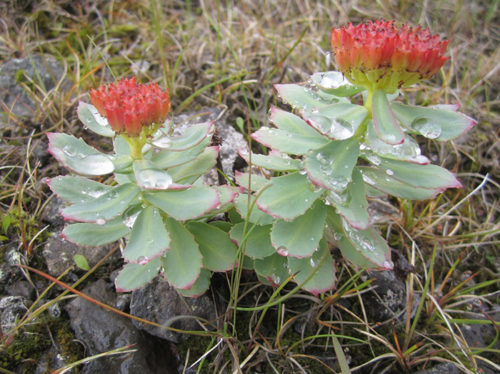
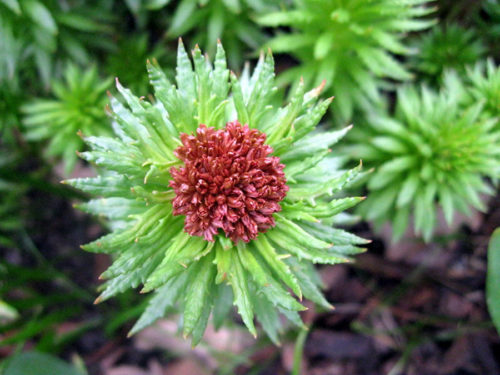
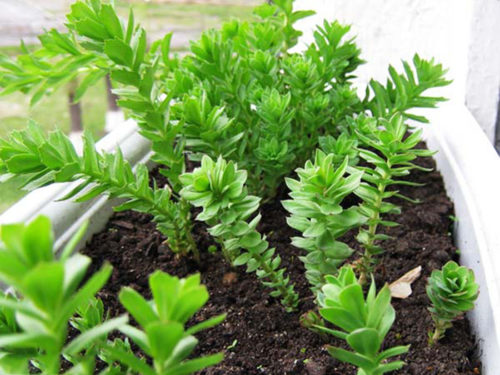
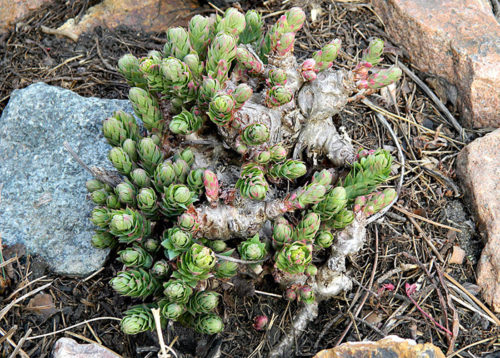

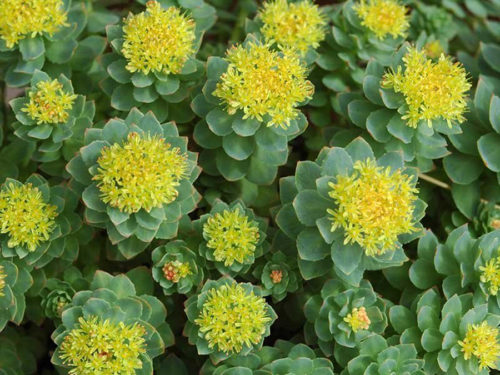
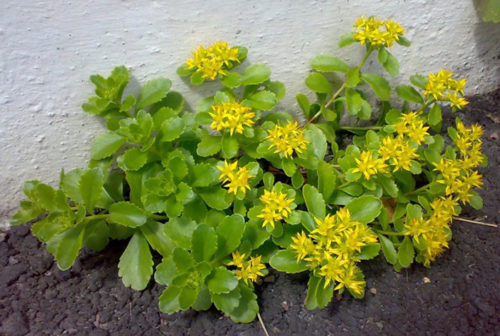
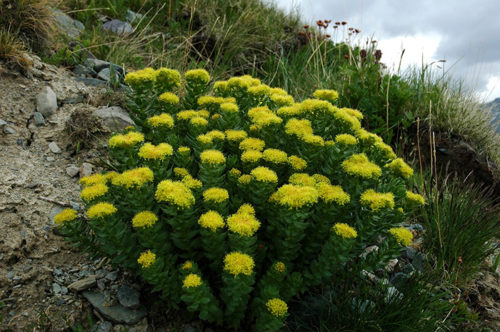
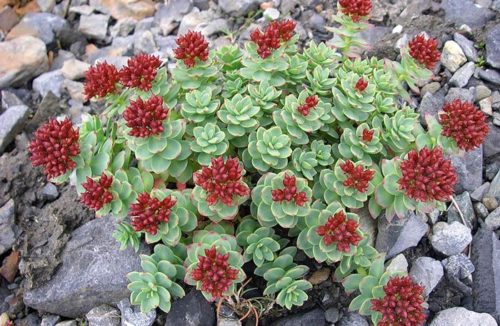












 Start a discussion ...
Start a discussion ...